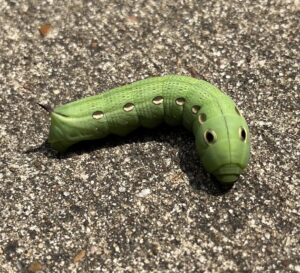by Shaila Palamand

Spring is a popular season for caterpillars to hatch. Those of you located in the Piney Woods area have, no doubt, noticed the current abundance of Salt Marsh caterpillars – the cute, fast-crawling critters decked out in a combination of black, orange and yellowish fuzz, munching on just about any plant they can find in order to fuel up for their ultimate metamorphosis. Salt Marsh moths are actually quite beautiful – snow white with black spots and orange highlights. But other beautiful lepidoptera such as Tersa Sphinx moths and Spicebush Swallowtail butterflies are also getting their start this season, and their caterpillars, while not as prolific as the Salt Marsh variety, are easy to spot if you know what to look for. Just keep an eye out for eyes – or rather, “false” eyes known as eyespots.

The eye-like spots on these caterpillars differ greatly from their actual eyes in both appearance and location. Moreover, they are not functional; they are simply markings. However, they might still serve an important purpose.
One theory is that false eyes are intended to mimic other animals in order to deceive or discourage potential predators. In particular, predators that rely primarily on eyesight when hunting for prey (such as birds) might be intimidated by large eye-like spots that resemble something other than an easy-to-catch, tasty caterpillar.
Another idea is that eyespots are meant to draw attention away from the caterpillar’s actual eyes and other vital and vulnerable areas. In theory, a caterpillar may be more likely to survive an attack if a predator’s initial target is a relatively unimportant body part.
Even beyond the caterpillar stage, eyespots can also be found on the wings of many butterflies and moths, on either the ventral or dorsal side. The Common Buckeye, Painted Lady, and Little Wood Satyr butterflies, along with the striking Polyphemus moth, are great examples right here in East Texas.


